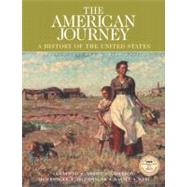
| (Note: Volume I includes Chapters 1-16; Volume II includes Chapters 16-31.) | |
| Volume I | |
| Worlds Apart | |
| Transplantation, 1600-1685 | |
| The Creation of New Worlds | |
| Convergence and Conflict, 1660s-1763 | |
| Imperial Breakdown, 1763-1774 | |
| The War for Independence, 1774-1783 | |
| The First Republic, 1776-1789 | |
| A New Republic and the Rise of the Parties, 1789-1800 | |
| The Triumph and Collapse of Jeffersonian Republicanism, 1800-1824 | |
| The Jacksonian Era, 1824-1845 | |
| Slavery and the Old South, 1800-1860 | |
| The Market Revolution and Social Reform, 1815-1850 | |
| The Way West | |
| The Politics of Sectionalism, 1846-1861 | |
| Battle Cries and Freedom Songs: The Civil War, 1861-1865 | |
| Reconstruction, 1865-1877 | |
| Volume II | |
| Reconstruction, 1865-1877 | |
| A New South: Economic Progress and Social Tradition, 1877-1900 | |
| Industry, Immigrants, and Cities, 1870-1900 | |
| Transforming the West, 1865-1890 | |
| Politics and Government, 1877-1900 | |
| The Progressive Era, 1900-1917 | |
| Creating an Empire, 1865-1917 | |
| America and the Great War, 1914-1920 | |
| Toward a Modern America: The 1920s | |
| The Great Depression and the New Deal, 1929-1939 | |
| World War II, 1939-1945 | |
| The Cold War at Home and Abroad, 1946-1952 | |
| The Confident Years, 1953-1964 | |
| Shaken to the Roots, 1965-1980 | |
| The Reagan Revolution and a Changing World, 1981-1992 | |
| Complacency and Crisis, 1993-2003 | |
| Table of Contents provided by Publisher. All Rights Reserved. |
The New copy of this book will include any supplemental materials advertised. Please check the title of the book to determine if it should include any access cards, study guides, lab manuals, CDs, etc.
The Used, Rental and eBook copies of this book are not guaranteed to include any supplemental materials. Typically, only the book itself is included. This is true even if the title states it includes any access cards, study guides, lab manuals, CDs, etc.